The spectacular coastal roads of east Bali are an adventure in their own right, with green hills on one side and stunning cliffs and open ocean views on the other.
The east coast of Bali is more than just a haven for divers and snorkelers, the area offers a peek into local livelihoods. From temples to fishing villages, tourist towns to seaweed farms, the eastern part of Bali is buzzing with life.
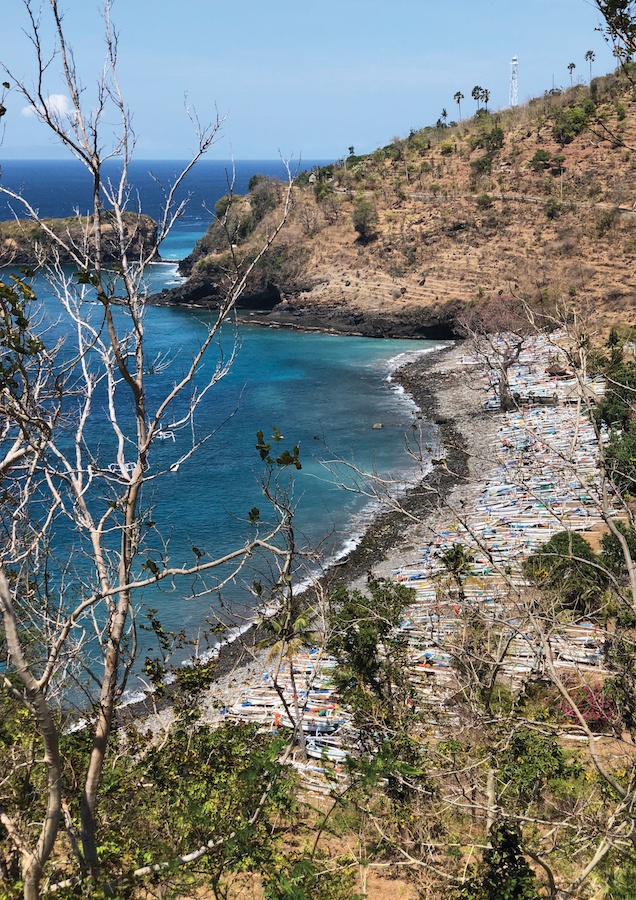
Just like the north coast, the east coast is an area less visited by the millions of visitors to the island. No surfing spot is to be found here and the beaches are short bays rather than the long stretches found on the south coast. Yet east Bali entertains visitors with dramatic, panoramic landscapes and rich, colourful underwater life that lies beneath the calm wave. The people here also follow a slower pace of life, still maintaining a traditional lifestyle. This is what makes the east coast a great area for cultural experiences.
Karangasem regency on the east coast was once a powerful kingdom with captivating landscapes, fascinating history, boisterous traditional markets, and grand palaces. In addition, the regency is home to a big number of coastal villages that you’ll come across as you drive through the region’s winding, scenic roads.
One of the first of these villages you’ll encounter is Padangbai. Although the sleepy little fishing village boasts a busy port that links Bali and Lombok, Padangbai so far hasn’t been affected by the rapid development that’s taking place in other tourist destinations around the island. Visitors to the village are mostly divers and tourists who are looking to get aboard ferries to the neighbouring islands further east. Some of the latter end up cancelling their plans to spend more time in the village. They find Padangbai to be enchanting with its secluded beaches, numerous diving sites and cultural attractions.
For a quiet village, Padangbai does have a long and significant history. Up until the turn of the century, it was first known as Padang village for its grassy sloping hill. The Dutch, who used the port for military purposes, added the word “Bay,” after the original name. Today Padangbai is mostly known as a scuba diving haven. A great variety of marine life thrives in great numbers in the sea between the bay and the neighbouring islands of Nusa Penida and Nusa Lembongan. There are many dive sites around the area that will satisfy divers of all skill levels.
You’ll find local villagers selling their freshest catch of the day scattered along the main road leading to the Padangbai intersection. If you’re up for a seafood barbecue dinner, then you may want to stop and buy some fresh tuna to bring home.
From Padangbai back to the main road and heading further east will take you to the little coastal town of Candidasa. At one point in history Candidasa used to be the only popular destination for day-tripping to East Bali – more of the region has been revealed over time. The region’s main road, which runs parallel to the coastline, houses rows upon rows of beach resorts, restaurants, convenience stores, art shops, and bars. In addition to the cliche leisure spots, here also nestles Pura Candidasa, a temple dedicated to Bali’s goddess of fertility and is where Balinese Hindus come to pray to be blessed with an abundance of children.

The story of the temple is a charming one: there was a goddess named Hariti who was infertile but wanted offspring to continue her godly bloodline. She fell in love with a handsome god but failed to provide him an heir. One day, she heard some Balinese people praying for rain and when she looked down from her perch in heaven, she saw a Balinese couple who offered their prayers, standing atop a high hill and addressing their prayers to the clouds.
Sure, they wanted rain, but Hariti knew that they lacked much more. She knew that they were barren – unable to produce a child that they wanted so badly. The goddess took pity on them; their plight made her so sad that she began to cry and her tears fell as rain upon the couple. In the heat the moment, presumably caused by the magic raindrops, the couple had a sudden surge of unstoppable passion and made love right then and there. No doubt by now you’ve guessed that their spontaneous union resulted in a pregnancy and the birth of their first offspring. And from that moment on, the goddess Hariti was fertile. So fertile that she immediately gave birth to ten children thereby making her god-husband very happy.
From that time until now, this hilltop temple is the place where the Balinese come to pray for fertility and rain – not necessarily in that order. Much of the actual history of this temple is long-gone but the myths remain. All that is known is that it was constructed in the eleventh century and it received its most recent major renovation in 1961. Right on the main road, it’s a very long flight of steps up the steep hillside all the way to the statue of the goddess Hariti – the statue of a very happy woman surrounded by lots of small children.
Across the road from the temple, slightly to the left, you’ll find a vast lotus pond. Here you can take a quick break while soaking in the natural beauty of the area before continuing the journey.
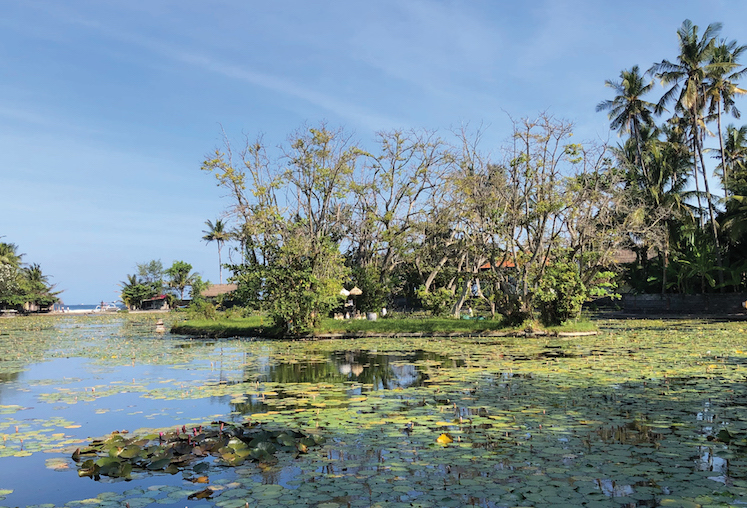
Moving on, following the road will take on a journey through the hills of east Bali. Once passing the hills and into the next small village, you may want to pay attention to the road signs and look for the one that says “Virgin Beach”.
Of the several beaches in East Bali, Virgin Beach is probably the most popular amongst the tourists. The beach goes by several names; some tourists refer to the beach as White Sand Beach, while the locals call it Pantai Bias Putih. It’s situated at the end of a southbound trail, passing a narrow village road. The stretch of white sandy beach here is more or less secluded with clear blue water in varying hues. But don’t get carried away by the magnificent beauty that surrounds you because the current here is rather strong.
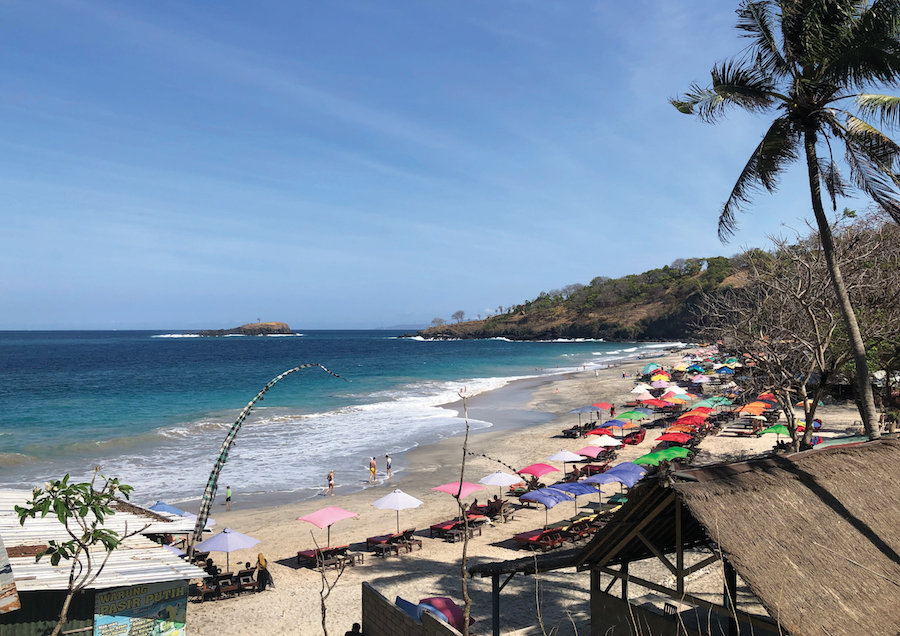
There are beach hut restaurants offerings fresh seafood and classic Indonesian fares such as mie goreng and nasi goreng, as well as fresh coconut water and soft drinks. Here, dolphins can be spotted from the beach, usually in the afternoon.
A visit to Karangasem regency on the east cost of Bali also allows travellers to step back in time as they wander through the beautiful, manicured gardens of the Karangasem water palaces. The Balinese kingship spanned from early 10th to early 20th century, with Karangasem being one of the nine kingdoms. These kingdoms were known to have flourished, enriched, and shaped the island’s culture through establishing the sophisticated Balinese court culture that combines the Hindu influences with Bali’s own native spiritual elements and ancient reverence.
Kings then built their palaces that acted as the centres of power, a place where they initiated and preserved laws, and held rituals in which their subjects could be involved. In east Bali, the last King of Karangasem in the late 20th century built Taman Ujung and Tirta Gangga to add to his Puri Agung Karangasem Royal Palace. At present, both Taman Ujung and Tirta Gangga are some of Bali’s major attractions, inviting visitors to Bali to be enthralled especially by the water features of the two royal sites that make up the quieter eastern side of Bali.
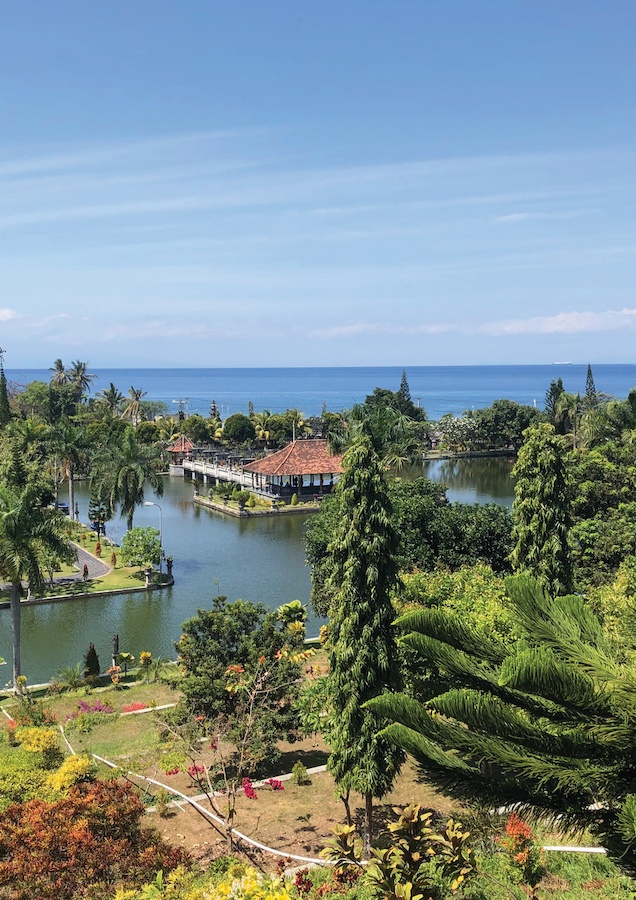
In Tumbu village, where the charming Karangasem countryside takes over the view, you will find Taman Ujung constructed by the late King of Karangasem, I Gusti Bagus Djelantik that reigned from 1909 until 1945. It was built to welcome and serve visiting dignitaries and kings from neighbouring countries, besides for the pleasure of the king and his royal family. Loosely translated to “the garden on the edge”, Taman Ujung is unique with old omissions and beautiful fish ponds that surround its premises, while keeping the high value history of the empire of Karangasem in East Bali.
Standing on the main round pavilion of Taman Ujung will give you the best panoramic views of the Lombok Strait, the silhouette of Mount Lempuyang, and the serene views of the surrounding area.
From Taman Ujung, you can continue your journey to Amed, passing the area of Seraya. Sited on a hilly area, Seraya offers a glimpse of how a typical village would look like. A cautious drive is highly advised in this area, especially during rainy days like now when the narrow road tends to be slippery.
Once you enter Amed, you’ll be greeted by a stunning coastal view, yet different from its southern counterparts. Amed consists of landscapes and a series of headlands overlooking bays, lined with colourful fishing boats resting on the area’s black sandy beaches.
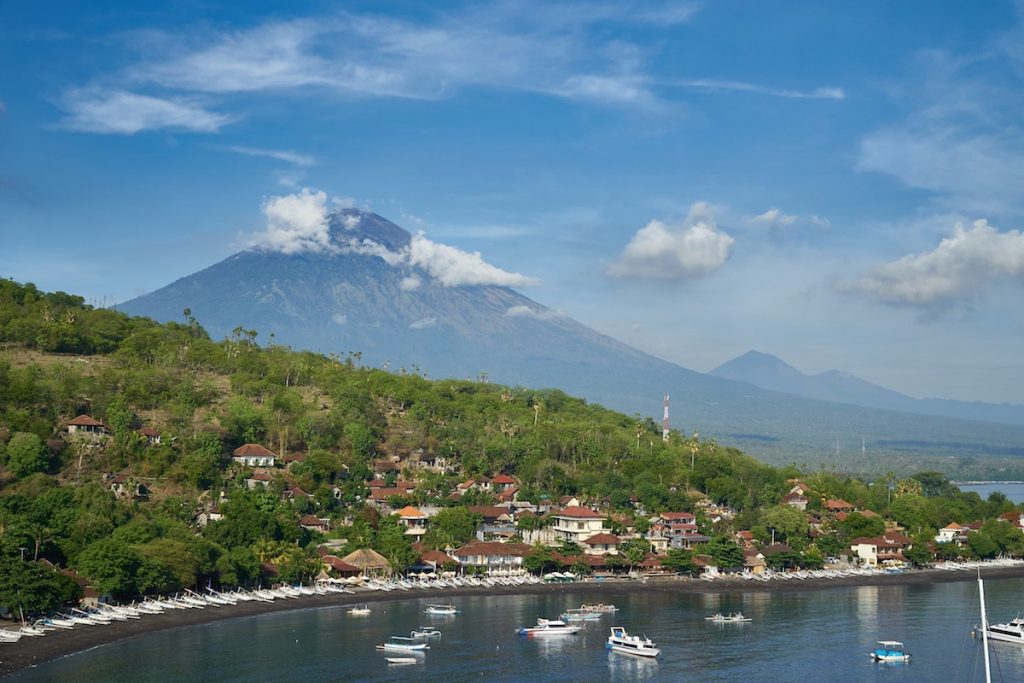
The central area would pretty much be like Legian in Kuta; the difference is, instead of myriads of bars and clubs, both sides of the road in this area are packed with hotels, villas, restaurants and dive centres. Also, sited along the cliff, the road provides spectacular sceneries of the beaches below. The atmosphere here is very calm and peaceful, making it ideal for those seeking private moments away from the loud music and crowd that are regularly taking place in southern part of the island.
Several cliff-edge areas have been cleared, such as the spot where visitors can have the best bird’s eye view of Amed’s Jemeluk Bay, offering beach views backdropped by the great Mt.Agung.
Also making Amed their home are the island’s salt farmers. Again, now that beachfront accommodations taking over a good portion of beach Amed’s beach areas, there’s currently only a handful of locals maintaining their humble lifestyle from salt farming – with Wayan Sukiarni being one of the very few.
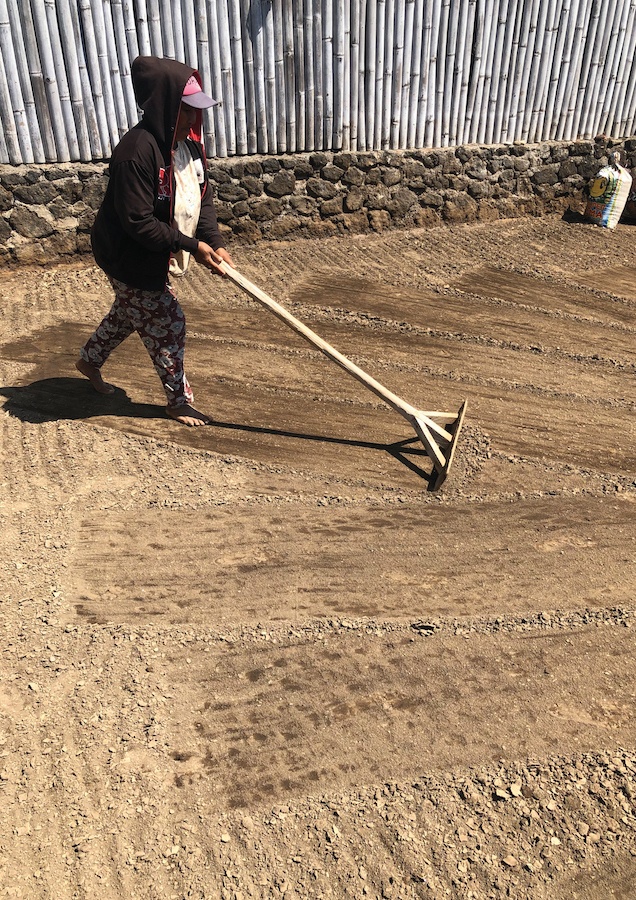
Belonging to a group called MPIG Garam Amed Bali (Bali Amed Salt Producer), Wayan has been a salt farmer for more than 30 years now, working on a small space sandwiched between beachfront restaurants. Wayan’s small flat terrain by the beach, where sea seawater, after being collected from the ocean, is left to evaporate leaving salt crystals behind, is an attraction for the tourists having a bite at surrounding restaurants. To collect the seawater, Wayan carries two baskets that are connected by a long strip of bamboo across her shoulders. She will then spray the seawater onto the flat terrain, making it muddy. After being left to evaporate, leaving salt crystals behind, Wayan will then collect the salt in a series of wooden containers.
You can purchase the freshly farmed sea salt here. Wayan sells it by the kilogram, or if you want to purchase the salt as a souvenir, she’s also prepared attractive packaging made from woven coconut leafs.
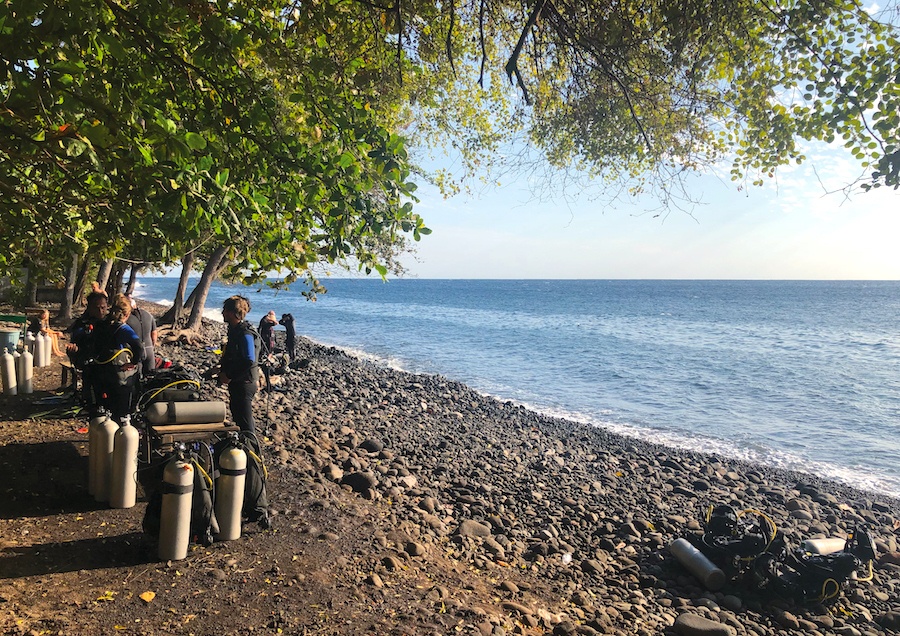
From Amed, take the
coastal road up north to a remote fishing village called Tulamben, an area that
has been transformed from a dry, unattractive and arid village into a diving
and snorkelling paradise. Its remarkable underwater life has attracted
thousands of divers across the world to this once sleepy fishing village. Best
known as the home of the USAT Liberty shipwreck, one of Bali’s main diving
attractions, Tulamben offers a relaxing ambiance with rough and slightly arid
overland terrain; even the name of the area loosely translates to ‘rock-strewn’
in the Balinese language. But unlike the sandy beaches of Amed or those on the
south coast, the ones found here are uniquely pebbly.












